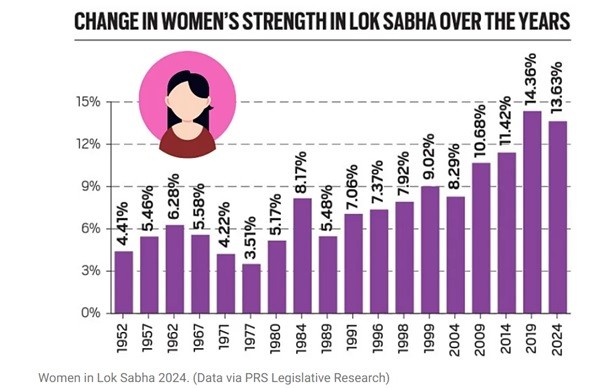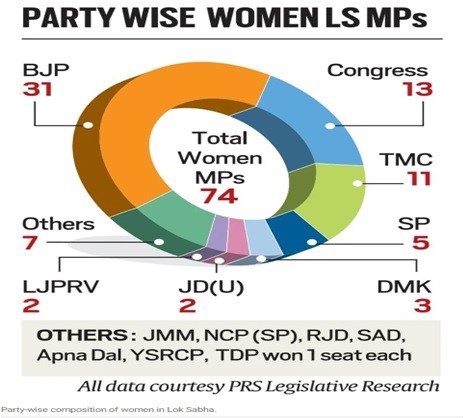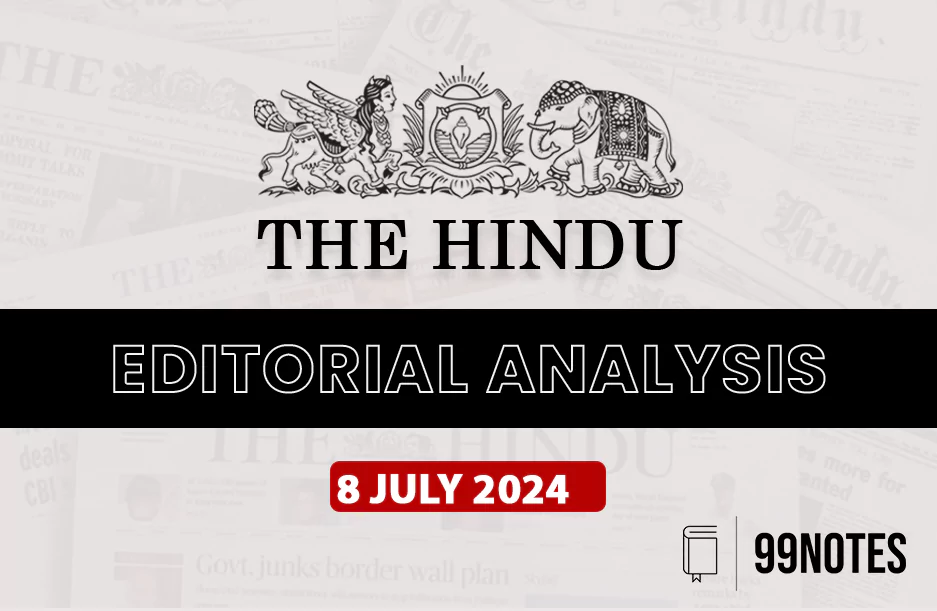8 July 2024 : The Hindu Editorial Analysis
1. A law around low-carbon climate resilient development
(Source – The Hindu, International Edition – Page No. – 8)
| Topic: GS2 – Indian Polity – Judiciary |
| Context |
|
Introduction
- The Supreme Court of India recently acknowledged a new right: the freedom from adverse impacts of climate change, derived from the rights to life and equality.
- The discussion focuses on the necessity of protecting this right effectively through legislative measures tailored to India’s specific conditions.
Need for Climate Legislation
- Judicial interventions alone are insufficient for addressing the systemic challenges posed by climate change.
- Advocates propose climate legislation as a comprehensive approach to safeguarding rights and guiding developmental decisions.
Goals of Climate Law
- Climate legislation must integrate low-carbon and climate-resilient principles into everyday decision-making across all levels of governance.
- It aims to counteract climate vulnerabilities, especially among vulnerable communities, ensuring social justice alongside environmental sustainability.
- Several countries have enacted ‘framework climate laws’ to enhance governance capacities for climate action.
- These laws establish overarching goals, processes, and accountability measures to embed climate considerations into governmental practices.
Tailoring Climate Law to India
- India’s approach must consider its low per capita emissions compared to global averages, coupled with ongoing emission growth.
- The law seeks to maximise development while minimising carbon footprints and enhancing resilience against climate impacts.
Institutional Structure and Decision-Making
- A proposed ‘low-carbon development commission’ could provide expert guidance and policy options to national and state governments.
- It would foster inclusive decision-making processes, ensuring that diverse stakeholder perspectives, including those of vulnerable groups, are considered.
- A ‘climate cabinet’ comprising key ministers and state representatives would oversee strategic climate policy formulation and implementation.
- This body aims to streamline decision-making and break down silos that hinder coordinated climate action across ministries.
Enhancing Governance Capacity
- The Ministry of Environment, Forest and Climate Change’s Executive Committee on Climate Change could be revitalised with legal mandates and expanded responsibilities.
- This would strengthen inter-ministerial coordination and ensure effective implementation of climate policies at the national level.
Engaging Subnational Governments
- Recognizing the pivotal role of state and local governments in climate action, the law should facilitate access to national scientific resources and funding mechanisms.
- It proposes aligning centrally-sponsored schemes with climate goals and fostering cooperative decision-making between the Centre and states.
Financial Mechanisms for Climate Resilience
- The law could mandate climate-tagging of expenditures and require periodic updates of medium-term climate plans by both Centre and states.
- This approach aims to incentivize local climate resilience initiatives and ensure consistency in national and regional climate strategies.
Conclusion
- The Supreme Court’s landmark decision underscores the urgency of enacting robust climate legislation in India.
- Such legislation is pivotal in steering national development towards a sustainable, low-carbon future while upholding principles of justice and resilience against climate impacts.
| PYQ: Q.1 Clean energy is the order of the day. Describe briefly India’s changing policy towards climate change in various international fora in the context of geopolitics. (UPSC CSE (M) GS-2 2022) Q.2 ‘Climate Change’ is a global problem. How will India be affected by climate change? How Himalayan and coastal states of India are affected by climate change? (250 words/15m) (UPSC CSE (M) GS-3 2017) |
| Practice Question: Discuss the significance of the Supreme Court’s recognition of a right ‘free from adverse impacts of climate change’ in India’s constitutional framework. How can robust climate legislation contribute to achieving sustainable development goals while ensuring social equity? (250 Words /15 marks) |
2. The ANRF plan has got off on the wrong foot
(Source – The Hindu, International Edition – Page No. – 8)
| Topic: GS2 – Governance |
| Context |
|
Introduction
- In 2023, the Indian Parliament passed the Anusandhan National Research Foundation (ANRF) Bill to enhance research capabilities in India, particularly in universities and colleges.
Goals and Initial Reception
- The ANRF aims to seed and grow outstanding research cells in State Universities, providing a funding boost and reducing bureaucratic constraints.
- Initially welcomed by the scientific community, it was seen as a crucial step towards fostering independent and innovative research in academia.
Governance Structure Concerns
- Recently, the ANRF formed a Governing Board and Executive Council lacking representation from key stakeholders like Central and State universities.
- The composition primarily includes government officials and international experts, raising concerns about practical understanding of ground-level issues in the Indian research ecosystem.
Industry Representation
- Despite plans to raise over 70% funding from non-government sources and industry, the current boards lack adequate representation from Indian industry or entrepreneurs.
- The absence of diverse perspectives hampers the ANRF’s goal to collaborate effectively with industry and harness private sector support for research.
Funding Challenges and Overhaul Needs
- India’s underfunding of research and development necessitates increasing the R&D budget to 4% of GDP and reforming funding mechanisms.
- The ANRF must streamline grant management, implement efficient peer-review systems, and ensure timely disbursement of funds to researchers and institutions.
Administrative Reforms Needed
- To operate effectively, the ANRF should streamline bureaucratic processes, allowing flexibility in fund usage and exempting from stringent government financial rules.
- This includes facilitating direct purchases outside the Government e-Marketplace (GeM) portal to expedite research activities.
Enhancing Committee Diversity
- A diverse representation of natural and social scientists from universities, including women and young entrepreneurs, is essential.
- This diversity ensures informed decision-making and bridges the gap between research and teaching in Indian universities.
Leadership and Strategic Vision
- The future CEO of ANRF should possess a blend of industry and academic experience, capable of fundraising and navigating the global innovation ecosystem.
- Such leadership is crucial to prevent ANRF from mirroring typical bureaucratic structures and to foster meaningful research-teaching integration.
Conclusion
- The ANRF holds promise in revitalising India’s research landscape but faces critical challenges in governance, industry engagement, funding mechanisms, and administrative efficiency.
- Addressing these concerns through inclusive governance and strategic reforms is essential to realise ANRF’s potential as a catalyst for transformative research in India.
| PYQ: Scientific research in Indian universities is declining, because a career in science is not as attractive as our business operaSons, engineering or administration, and the universities are becoming consumer oriented. Critically comment. (200 words/12.5m) (UPSC CSE (M) GS-3 2014) |
| Practice Question: Discuss the objectives and challenges associated with the Anusandhan National Research Foundation (ANRF) in India. Analyse the governance structure and representation issues affecting its effectiveness in promoting research and development. (250 Words /15 marks) |
3. Representation of women in the Lok Sabha
(Source – The Hindu, International Edition – Page No. – 9)
| Topic: GS2 – Indian Polity |
| Context |
|

Analysis of the news:
- Historical Representation: Women’s representation in the Lok Sabha has increased over the decades. Starting from 4.5% in the first Lok Sabha (1952) to 14.4% in the 17th Lok Sabha (2019), it currently stands at 13.6% in the 18th Lok Sabha (2024).
- Party-wise Trends: The BJP slightly increased its proportion of women candidates from 12.6% in 2019 to 15.7% in 2024 but saw a decline in success rate (74.6% to 44.9%). The Congress maintained a consistent share of women candidates (12.3%) but increased their success rate from 11.5% to 18.8%. Trinamool Congress, despite fielding fewer candidates, had a high success rate (91.6%).

- Current Representation: Trinamool Congress leads with 37.9% women MPs, followed by Congress (13.1%) and BJP (12.9%) in the 18th Lok Sabha.
- Women voters showed diverse preferences across states in 2024. Trinamool received majority support from women in West Bengal, while Congress had significant backing in Karnataka. BJP/NDA garnered substantial votes in Bihar, Haryana, Madhya Pradesh, Delhi, and Rajasthan among women voters.
| Practice Question: Discuss the trends in women’s representation in the Lok Sabha from 1952 to 2024. Analyse the strategies and success rates of major political parties in fielding and electing women candidates, with specific reference to recent elections. (250 Words /15 marks) |





